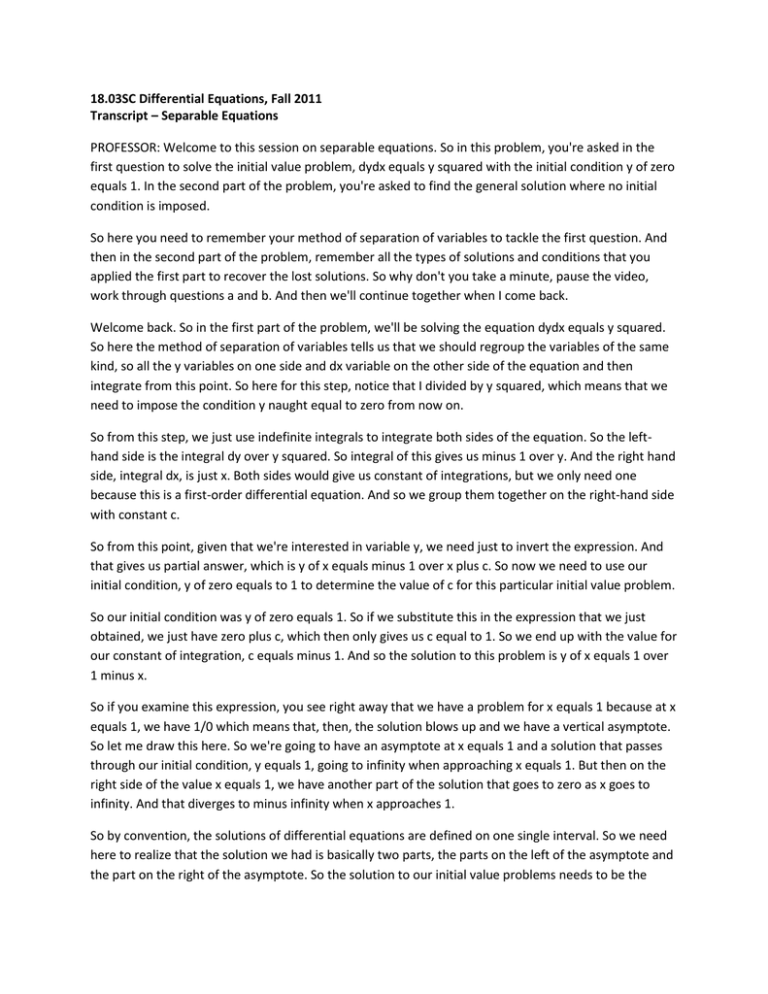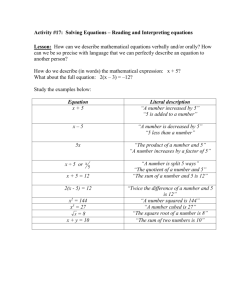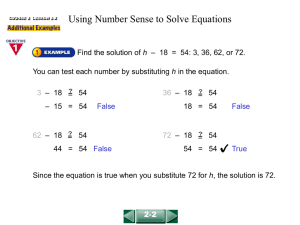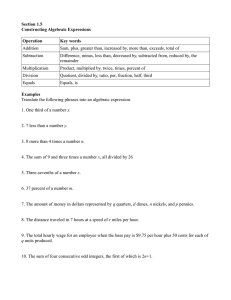18.03SC Differential Equations, Fall 2011 Transcript – Separable Equations
advertisement

18.03SC Differential Equations, Fall 2011 Transcript – Separable Equations PROFESSOR: Welcome to this session on separable equations. So in this problem, you're asked in the first question to solve the initial value problem, dydx equals y squared with the initial condition y of zero equals 1. In the second part of the problem, you're asked to find the general solution where no initial condition is imposed. So here you need to remember your method of separation of variables to tackle the first question. And then in the second part of the problem, remember all the types of solutions and conditions that you applied the first part to recover the lost solutions. So why don't you take a minute, pause the video, work through questions a and b. And then we'll continue together when I come back. Welcome back. So in the first part of the problem, we'll be solving the equation dydx equals y squared. So here the method of separation of variables tells us that we should regroup the variables of the same kind, so all the y variables on one side and dx variable on the other side of the equation and then integrate from this point. So here for this step, notice that I divided by y squared, which means that we need to impose the condition y naught equal to zero from now on. So from this step, we just use indefinite integrals to integrate both sides of the equation. So the lefthand side is the integral dy over y squared. So integral of this gives us minus 1 over y. And the right hand side, integral dx, is just x. Both sides would give us constant of integrations, but we only need one because this is a first-order differential equation. And so we group them together on the right-hand side with constant c. So from this point, given that we're interested in variable y, we need just to invert the expression. And that gives us partial answer, which is y of x equals minus 1 over x plus c. So now we need to use our initial condition, y of zero equals to 1 to determine the value of c for this particular initial value problem. So our initial condition was y of zero equals 1. So if we substitute this in the expression that we just obtained, we just have zero plus c, which then only gives us c equal to 1. So we end up with the value for our constant of integration, c equals minus 1. And so the solution to this problem is y of x equals 1 over 1 minus x. So if you examine this expression, you see right away that we have a problem for x equals 1 because at x equals 1, we have 1/0 which means that, then, the solution blows up and we have a vertical asymptote. So let me draw this here. So we're going to have an asymptote at x equals 1 and a solution that passes through our initial condition, y equals 1, going to infinity when approaching x equals 1. But then on the right side of the value x equals 1, we have another part of the solution that goes to zero as x goes to infinity. And that diverges to minus infinity when x approaches 1. So by convention, the solutions of differential equations are defined on one single interval. So we need here to realize that the solution we had is basically two parts, the parts on the left of the asymptote and the part on the right of the asymptote. So the solution to our initial value problems needs to be the solution that passes through the imposed initial condition, which was y of zero equals to 1. So it needs to be this solution. So now, if we move on to the solution of the second part of the problem b, we were asked to find the general solution of the problem, which means that we need to account now for all the solutions, regardless of their initial condition. So we already answered this partially during the solution of part a where we solved using indefinite integrals and arrived to the solution minus 1 over x plus c, where here we had, basically, an undetermined constant of integration. So this is one general solution. But remember that we need to give all the solutions of the problem. So when we arrived at the solution, we excluded the solution y equals zero, which was basically a lost solution because we had to impose the condition y not equal to zero. So we need when we give the general solution to this differential equation to recover the lost solution. And then we basically have one kind of solution, minus 1 over x plus c, that excludes y equal to zero and another kind of solution that is simply the zero solution. So to summarize, the important points of this problem is to remember the separation of variables and how to use it and the fact that using it imposes conditions that require us to recover lost solutions at the end of the problem if we're asked to give general solution. Another point to remember is that even a simple ODE can lead to relatively complex behavior which drives the presence of this vertical asymptote that you need to then know how to deal with and determine which part of the solutions that you've obtained is the real solution to the initial value problem that you're given. So I hope that you are OK with this problem and you will use these approaches many times for the rest of the course. MIT OpenCourseWare http://ocw.mit.edu 18.03SC Differential Equations. Fall 2011 For information about citing these materials or our Terms of Use, visit: http://ocw.mit.edu/terms.







